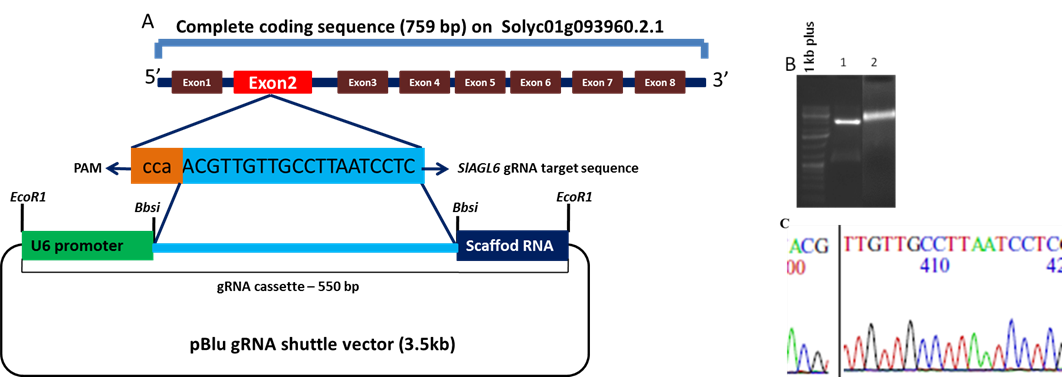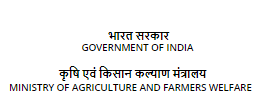CRISPR/Cas9-AGL6 Binary Vector Construct

Background:
Seedlessness is a desired trait in elite cultivars intended for the fastidious consumers who find the seeds to impair the processing quality of the fruits. Seedlessness can be of advantage for processed tomato products because the energy invested in separating the seeds from the processed product can be saved. Thus parthenocarpy can be beneficial to seed companies as it assists in protecting their varieties. SlAGAMOUS-LIKE 6 (SlAGL6) is one of the transcription factor (TF) of MADS-box TF family (Smaczniak et al., 2012). Recently, the MADS-box gene AGL6 was shown to regulate parthenocarpy in tomato, and the loss function of SlAGAMOUS-LIKE 6 resulted in tomato facultative parthenocarpy (Klap et al. 2017). The present innovation named " CRISPR/Cas9-AGL6 binary vector construct" was created to generate parthenocarpy tomato fruits.
Technology Details:
Parthenocarpy is the growth of ovary into a seedless fruit in the absence of pollination or/fertilization. AGAMOUS, DEFICIENCE and SRF (MADS) box gene, also caused seedless fruits (Ampomah-Dwamena et al. 2002). Recently, the MADS-box gene AGL6 was shown to regulate parthenocarpy in tomato, and the loss function of SlAGAMOUS-LIKE 6 resulted in tomato facultative parthenocarpy (Klap et al. 2017). SlAGL6 encodes for a MADS-box protein belonging to the type II lineage MIKCC, subfamily AGL6, of the MADS-box transcription factor family (Smaczniak et al., 2012). In tomato parthenocarpy fruits, SlAGL6acts as a key regulator of the transition between the state of ‘ovary arrest’ imposed towards anthesis and the fertilization-triggered fruit set (Figure 1).
Figure 1: A model depicting the key role of SlAGL6 in the regulation of fertilization-dependent fruit set. (a): under normal conditions, expression of SlAGL6 allows ovary growth at Growth phase I until it reaches a higher level, during anthesis further growth of ovary is inhibited leading to “ovary arrest”. Anthesis followed by fertilization induces downregulation of SlAGL6 expression in the young embryo which enables growth and production of fully developed seeded fruit.; (b): Loss of “ovary arrest” function in Slagl6 mutant s causes enlargement of the ovary which continues even after anthesis at growth phase II and III allows fertilization independent development of seedless fruits. (The figure Adopted from Klap et al. 2017).
To generate parthenocarpy tomato fruits, CRISPR/Cas9-AGL6 binary vector construct was created. CRISPR/Cas9 technology was exploited to knockout the SlAGL6 gene (Solyc01g093960). SlAGL6 consists of 8 exons and its encoded protein has two domains viz., MADS-box domain (1-61 amino acid) and K-box domain (85-193 amino acid). Synthetic gRNA was designed to target the second exon of SlAGL6 (Figure 2A). It was incorporated into a Cas9 expressing binary vector and confirmed by restriction analysis and sequencing (figure 2 & 3).
Figure 2: Overview of SlAGL6 gene structure and SlAGL6 target gRNA cloning into shuttle vector: A) Schematic of SlAGL6 gene structure consisting of 8 exons with the complete CDS size of 759 bp. The chosen target guiding sequence(shaded in blue) for CRISPR/Cas9 modification in exon 2 of SlAGL6 is presented, the PAM (its reverse complement) shaded in orange is depicted in lower case letters, and all the restriction sites needed for cloning are represented. B) Gel picture showing the release of gRNA cassette of 550 bp (Lane 1) and unrestricted gRNA plasmid (Lane 2). C) Chromatogram peaks showing cloning of AGL6 gRNA sequence.
Figure 3: Overview of the development of Cas9 construct: A) Schematic of Cas9 construct harboring Cas9 (41139 bp) under 2x 35S promoter (768 bp) and Nos terminator (257bp) followed by gRNA cassette (U6-SlAGL6 gRNA-scaffold RNA). Bar gene resistance to glufosinate, T-DNA RB (right boarder) and LB (left boarder) are presented. Bacterial selection by Kanamycin resistance (Kan R) gene is also presented. B) Gel picture showing the release of gRNA cassette of 550 bp (Lane 2) and unrestricted MDC123-Cas9 plasmid (Lane 2). C) Overview of SlAGL6 gRNA cassette (U6-SLAGL6- gRNA-scaffold RNA) cloned in MDC123-Cas9 vector; U6 promoter (purple), slAGL6 sgRNA (blue) and scaffold RNA (orange).


